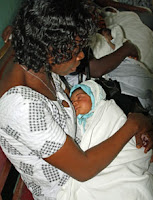Below is a note that the team from the recent--it's hard to believe we haven't even been home a week--Africa Partnership Station (APS) Mission to Ghana received from our fellow Ghana teammate and
Project HOPE volunteer Brian. Brian is wonderful volunteer and ER doctor in Colorado Springs. I thought readers would enjoy reading reflections about what he learned and coming home from an experience like APS.
Thanks for reading!
-Marisol

Email from Brian:
42 hours.
That is how long it took Marina and I to return home to Colorado Springs after leaving Sekondi- I think I slept about 6 hours of it. After we said good-bye to the last group in Frankfurt, Marina and I were the last two of the little HOPIES to make our way to the gate.
We "secured" seats with no one next to either one of us, spread out, and became fluent in German ("Rot Wein, Bitte") for the next ten hour journey. The plane ride turned into a series double then triple movie features, and yes, I finally finished off the last of Vicky Christina Barcelona.
Despite my listless, somber and stuperous sleepy state, I disembarked the plane to hear the words of my 2 year old daughter saying "Daddy's home, Daddy's home!" as she ran in circles and hopped/jumped around. I do not think any one of us in my family had a dry eye. Her epidemic joy infused me with happiness. "Taps" came early that night at 2100 after catching up with my family and telling stories.
0700 it was "heave out" and "breakfast for the crew". My request for "pop tarts" fell on puzzled eyes and shocked ears. The day was already so different from the others from the last 4 weeks with humidity and heat quickly replaced by clear, light, cold air, and a day filled with many watches and little time.
Being back now for a few days, I think what I have learned over the last month. When colleagues ask me "How was Ghana?", I am still stumbling in putting the whole experience into a well rehearsed paragraph to be spit out with ease without loosing their attention.
I have learned how resilient many people are around the world. I have learned and re-enforced my belief that people are generally good. I have learned that one can diagnose malaria by touching one's forearm. I have become better at looking at one's eyes to tell varying degrees of anemia, but despite how pale, their life and soul fluoresces. I have learned that influencing or educating just one person can make a difference in care that will be provided, and tomorrow the person they touch will be better for it. I have learned that we need to take great time and effort to establish peoples' trust, and it is only through side-by-side education will our efforts transform into action.
I hope everyone is settling back into their routines without difficulty but somewhat changed from the whole experience somewhat different. I appreciate the friendships that have been formed and the memories.
Perhaps I'll see you on another mission,
- Brian
 Project HOPE began working to fight tuberculosis (TB) disease in Kazakhstan in 1993, piloting early DOTS programs, which are the current international standards for TB control. In the 1990s, the break up of the Soviet Union led to serious deterioration in the health systems in Central Asian Republics (CAR), leading to poor health outcomes and drastic increases in the number of reported TB cases.
Project HOPE began working to fight tuberculosis (TB) disease in Kazakhstan in 1993, piloting early DOTS programs, which are the current international standards for TB control. In the 1990s, the break up of the Soviet Union led to serious deterioration in the health systems in Central Asian Republics (CAR), leading to poor health outcomes and drastic increases in the number of reported TB cases.



















 Below I am also copying something I saw on plaque at one of the castles about the region’s culture.
Below I am also copying something I saw on plaque at one of the castles about the region’s culture.



















